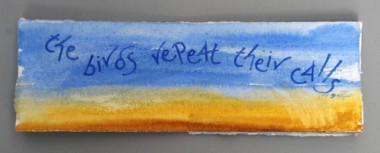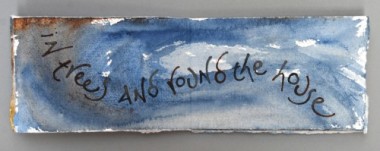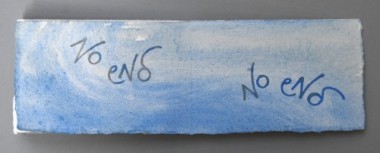I’ve recently been working on a very exciting project: an artist’s book on a similar scale to my huge Thames to Dunkirk (now in the British Library) but with a very different concept. I’ll be showing it as an installation at the beautiful Bloomsbury gallery that is the new home of poetry publisher Enitharmon Press, from 22nd September to 17th October. [Please note the exhibition is now closing on 15th October.]
I’ve set all 55 poems of Songs for Sappho, a brand new love song cycle by celebrated poet and author Maureen Duffy, whose 80th birthday was marked last autumn at a splendid Symposium at King’s College, London, her alma mater. The poems chart the changing weathers of a passionate, living love, from longing in absence to delight in the joys of being together. All the moods and colours of the poems are reflected in their dazzling variety on sheets of handmade paper, to be bound together in a contemporary illuminated manuscript, or Book of Hours. But for their first flight, they will be shown in this installation, hung aloft in Enitharmon’s airy bright space like washing on the line, or prayer-flags in the breeze.
The title Paper Wings is from Maureen Duffy’s poem Life Writing (from Environmental Studies, Enitharmon 2013):
I box up
my archive, my writing life. Do I feel bereft
seeing it vanning away to its hope of an
afterlife? ‘We will be remembered in our songs,’
Sappho promised and Behn begged for her verses’
immortality. These children grow up and fly away
on paper wings or cruise like Milton’s fallen angels
through the ether, and I rarely visit unless asked.
The idea of the poems flying away on paper wings is present throughout this new song cycle, written during the same period as the poems in Environmental Studies. So many of the Songs are messages flying through the ether, virtual words spanning virtual space connecting the parted lovers. When I first read them, I saw them aloft like smoke signals or flying through space like paper darts, and later I came to see them as though slung up high from a fine unbreakable line between two fixed points, both connecting them and measuring/mapping the distance between them, while the words of the messages are lifted into the breeze like the beneficent mantras of prayer-flags.
Some of the poems are swift as Cupid’s arrow, some light and gauzy as a heart-shaped kite, while others hang heavy as wet washing on the line, and so I envisaged this installation allowing us to glimpse or catch these intimate messages in flight. But I also recognised Songs for Sappho as a true song cycle, a sequence of love poems in the eternal present, without a beginning – because this love is prefigured – and without the (apparently inevitable) end of the affair – world without end, amen – circling back on itself like the seasons in an endless cycle of renewal. This cyclic aspect suggested to me the physical form of a concertina artist’s book, where the linear sequence allows the end to turn back upon itself to join the beginning in an unbroken circle of continuity.
The circle is itself a recurring theme in these poems, from the two hemispheres that make up the lovers’ metaphysical world, to the ring where love and war fight it out, and the bowl of sky given by the poet to her beloved. And this world of love mapped by the lovers’ words and dreams is centred on the heart, a heart-shaped earth (like the ancient cordiform world map found buried in the archives of the Museo Correr in Venice), and completed, first, last and always, by the lovers’ ‘meeting lips’.
This is not to say that the weather of the world of love is unrelievedly sunny: many poems lay bare love’s pains and sorrows, absence, anguish and yearning, evoked by ‘the dead hand of winter’, heavy hanging clouds, wearying rain or imprisoning snow. Yet with the natural cycle, spring returns suddenly, ‘summer renews’, and the world is again alive for the lovers, a real solid physical earth, their ‘earthly Eden’ a ‘safe landing’ for the ‘loving symbols in wings’.
In the form of both the book and its pre-construction manifestation as an installation, I’ve aimed to reflect these themes and poetic preoccupations, allowing the connections to reveal themselves gradually as the reader moves through the cycle, without (I hope) blocking out other insights and interpretations. A primarily visual first response to a poem can sometimes open other ways of apprehending – revealing sounds, rhythms and structures more clearly, for example. I believe this love song cycle to be very important, a lasting work that will be widely celebrated and acclaimed, and I feel very privileged to have been given the opportunity by Maureen Duffy to work with the poems.
Here at The Pottery Press (our small tiny press, occasionally publishing limited edition artist’s books) we are also publishing a printed version of Paper Wings, a digital facsimile that combines some aspects of both the artist’s book and the installation, to accompany the exhibition at Enitharmon. The book (ISBN 978-0-9930171-0-0) is out on 22nd September, and will be the first printed edition of the poems. And there’s also a dvd version documenting the work; in this artist’s film, Maureen Duffy reads each poem as the pages of the book turn and the complete song cycle unfolds. The film was made here in the studio at Potters’ Yard by me and my partner the writer Frances Bingham, and is released by Potters’ Yard Arts, also on 22nd September. Both are available from The Pottery Press; contact thepotterypress[at]pottersyard.co.uk
In the exhibition, the Paper Wings installation is framed by other artworks, hung apparently more conventionally on the gallery walls, but these are also (mostly) artist’s books, made from a single sheet of handmade paper torn and folded into a sequence of pages; with these books, I aim to set the text so that it can be read both page-by-page, and as a single whole image. The wall-hung works continue the theme of airy phenomena set by Paper Wings, from Maureen Duffy’s great spiral galaxy in Spiral of light, or her ‘ropes of stars’ in Vision of the Floating City, to Jeremy Hooker’s ‘white birds’ which are the feet of dancing women flying round a flowery meadow in Women dancing in a field of poppies.
And of course, what also continues is my own visual response to these wonderful texts: when I first read Maureen Duffy’s novel Londoners many years ago, I saw the words (in her hero Al’s meditation about the Reading Room in the British Museum) flying round the dome of that great round space, as I saw Lorca’s dreams fly up, singing with joy, and Dylan Thomas’ ‘other air’ streaming again with ‘a wonder of summer’. The spiralling form of some of these books evokes that circling renewal of the seasonal cycle, while other books like No end (shown below, setting a stanza of Jeremy Hooker’s powerful poem Written in clay) take the form of an endless river flowing onwards… These simple forms folded from a single sheet of paper contain both individuality and unity, as the page-by-page sequence coexists with the completeness of the whole image, reflecting how the individual words combine in unexpected ways to create new meanings within the poem.
Some installation shots in the gallery follow:


















September 2, 2014 at 1:16 pm
Liz, this is wonderful, dynamic work. Energy is beauty, beauty is energy, as Van Gogh (or Blake) might have said.
Jerry
September 2, 2014 at 6:43 pm
Thank you, Jerry. How inspiring to get a response from a poet that’s a poem in itself.
Liz